Stephen Hawking believed humans must colonise other planets within 100 years or face extinction. His fear was that climate change, nuclear war, AI, or an asteroid impact could wipe civilisation off the face of Earth.
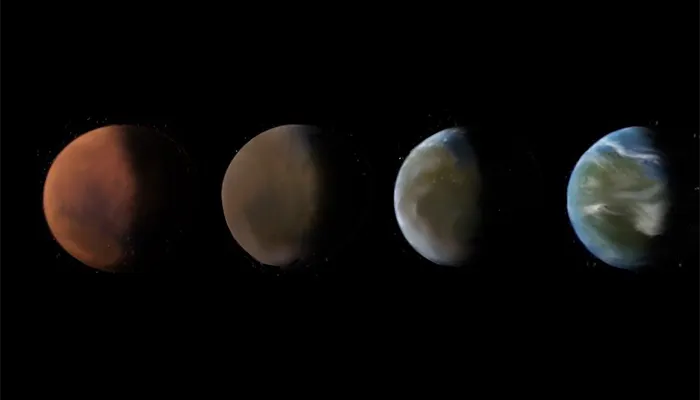
With these catastrophic threats hanging over us, our security as a species ultimately falls to colonising other planets and moons. The 100-year timeframe may be alarmist—but then again, things are really hotting up for humanity. And there's everything at stake.
It's no secret that Elon Musk wants to colonise Mars as a backup home for humanity. But the practicalities of terraforming and colonising the red planet are still largely theoretical. So what needs to be done?
What is it Like on Mars?
Life on Earth evolved over billions of years under specific environmental conditions including temperature, pressure, and gravity. Even if it were possible for humans to biologically adapt to live on Mars, it would take us vast evolutionary timeframes to do so.
The solution is to adapt Mars to our bodies instead. And this is where the biggest challenges lie—because in several critical ways, Mars is very different from Earth. Some of the biggest differences are:
No Magnetic Field. Mars lost its magnetic field long ago, which allowed solar winds to strip away its atmosphere. Creating an artificial magnetic field or magnetic shield will be a monumental engineering challenge.
Very Low Air Pressure. The thin atmosphere leaves Mars with a surface pressure of 6.5 millibars (less than 1% of Earth's 1,013 millibars). The lowest possible pressure for humans to survive is 62 millibars; below this our blood boils at body temperature.
Very Little Oxygen. Shout out to people who enjoy breathing. The atmosphere on Mars is 95% carbon dioxide (vs Earth's 0.04%) and 0.1% oxygen (vs Earth's 21%). While Arnie's eye-bulging experience in Total Recall was not realistic, the lack of oxygen would not be conducive to your survival.
Weaker Gravity. Mars has about 38% of Earth's gravity, and there's no known way to artificially increase a planet's gravity. Living there long-term would create major health problems, so we at least need to create higher gravity habitats.
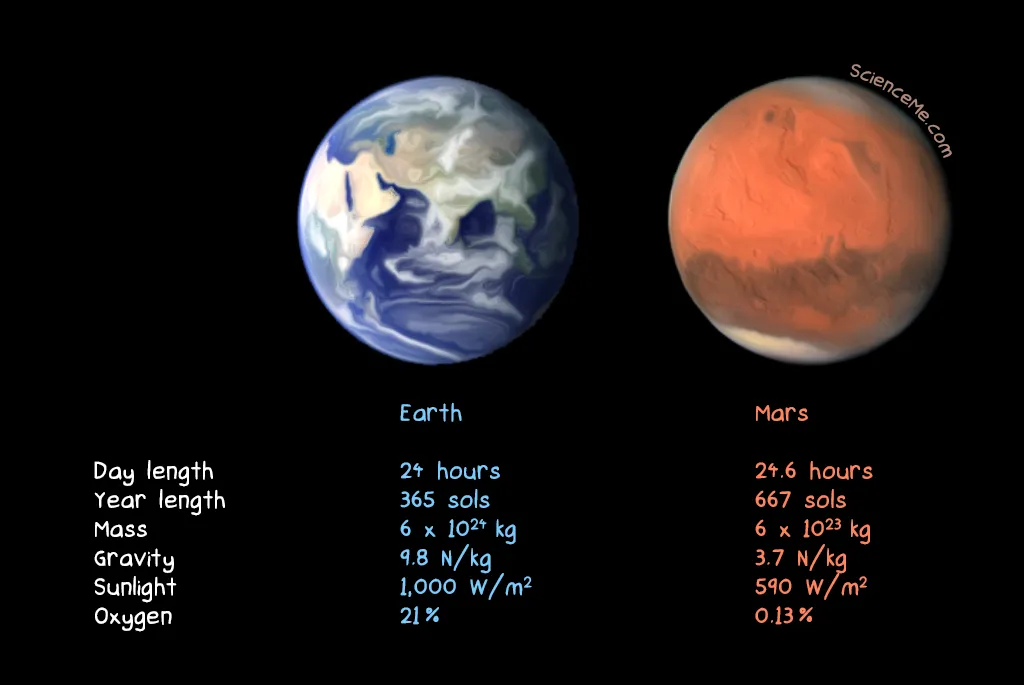
While Earth and Mars share some common ground, there are also some unforgiveable differences.
Terraforming Mars
In the 1940s, the science fiction author, Jack Williamson, gave us the term terraforming (literally Earth-shaping). It describes how we might modify the atmosphere, ecology, and surface topography of other planets to make them habitable to humans.
In reality, such a challenge is immense—many orders of magnitude greater than restoring our own runaway climate change. And yet, some star-gazing scientists are conceptualising ways we could terraform Mars on the basis that we must at least start somewhere.
"Who can doubt that if the first steps are taken, that the developments required to complete the job will not follow, for what is ultimately at stake is an infinite universe of habitable worlds." - Zubrin and McKay, Technological Requirements for Terraforming Mars
How to Heat Up a Planet
Perhaps the first task in terraforming Mars is to raise the temperature. Mars is further from the Sun, receiving 40% less light and heat than Earth. What's more, the thin atmosphere continually leaks out into space, making Mars extremely cold with an average temperature of -63°C (-81°F).
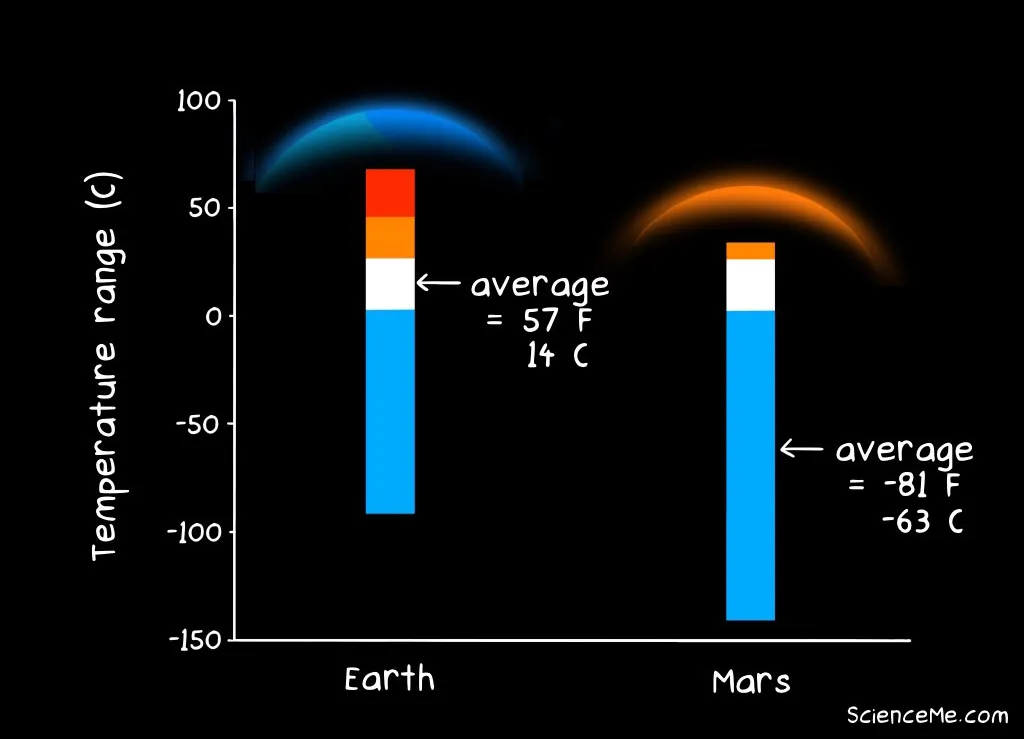
The temperature on Mars is much colder than on Earth.
So how do you warm a planet? Ironically, we already know one way. Humans have inadvertently warmed Earth by 1°C as a byproduct of industrialisation. So we might build uber-giant megafactories on Mars specifically designed to pump out halocarbon gases and create a greenhouse effect. Power requirements are on the order of 1000 MWe, which could modify the Martian atmosphere in as little as 50 years.
An alternative might be to place massive orbital mirrors around Mars. They'd need to be enormous—some 100km wide and weighing 200,000 tonnes—and produced in space out of asteroid or moon material. When angled to reflect sunlight onto Mars' south pole, they could melt vast amounts of frozen carbon dioxide which would thicken the atmosphere.
How to Create an Oxygen-Rich Atmosphere
Once Mars is warm enough, it could support photosynthetic bacteria. These are microorganisms that photosynthesise to convert sunlight into energy. In the process, they remove carbon dioxide from the air and add oxygen. These microorganisms play a huge role in our ecosystems on Earth and would be essential in terraforming Mars.
One way to do this is to cultivate bacteria in bioreactors on the red planet. They'd likely be genetically modified or at least artificially selected for their ability to thrive in Martian soil, which we already know contains iron, silicon, sulfur, magnesium, potassium, calcium, chlorine, sodium, and aluminium.
On the downside, Martian regolith (inorganic rock) contains 0.5% perchlorate which makes it pretty toxic to most terrestrial life. Humans like to use perchlorate in fireworks, road flares, explosives, and rocket fuel. Although we can wash the stuff out of the soil, there's a chance it modifies metal availability to the extent that plants won't grow. So we have to figure out new processes make Mars rock a viable growing substrate.
In the meantime, research has identified cyanobacteria that grow in 0.5% perchlorate and mined for perchlorate-resistant genes in salt-loving microorganisms. As with the beginnings of life on Earth, these single-celled critters will create an active biosphere, increasing the amount of oxygen and providing a buffer against solar winds carrying destructive high-energy radiation.
How to Find Water
While Mars does have water, it exists in the form of ice at the polar ice caps and beneath the surface, locked up in the rock. We can tap these resources by melting and drilling, respectively. The question is how much can we release and how many people could it sustain?
There's fierce debate over the potential to create oceans on Mars. Geological evidence suggests that rivers once flowed on the red planet, collecting in pools, lakes, and perhaps small oceans. Over time, the water became trapped in the planet's crust or escaped into space due to insufficient gravity.
But it's hard to quantify the size of these lost reservoirs based on remote sensing and rover studies alone. Computer models produce conflicting data, while some argue that Mars is simply too small to retain significant surface water.
Fortunately, oceans aren't essential to terraforming Mars. We can access vital water resources in other forms, like lakes, rivers, and underground aquifers, to drive settlement and agriculture.
These are just some of the long term challenges we have to figure out if we want to establish permanent settlers on Mars. It won't be enough to rely on artificial habitats, life support systems, and regular shipments from Earth, as this undermines the vision of independent colonies which can survive with or without us.
Yet none of this deters SpaceX, which is gearing up for a crewed mission to Mars this decade. Likewise, numerous public and private agencies (including NASA, ESA, Roscosmos, ISRO, CNSA, Lockheed Martin, and Boeing) are also looking to seed the alien planet with life. How does that look in the short term?
How to Get to Mars
At the very earliest, SpaceX could send humans to Mars in the 2028-29 launch window. Their goal: to establish the first mining, power, and life support infrastructure. Just how fraught is this mission?
The moment we leave the protective shroud of the Earth's atmosphere and magnetic field, conditions in space become pretty inhospitable. The Starship must be equipped to overcome challenges as diverse as space debris ripping through the hull, to the safe disposal of passenger poo.
The shortest journey time to Mars is about six months, though it's usually longer due to the independent orbits of the planets. On close approach roughly every two years, Earth and Mars are 62 million km apart, while the average straight line distance at any time is 225 million km.
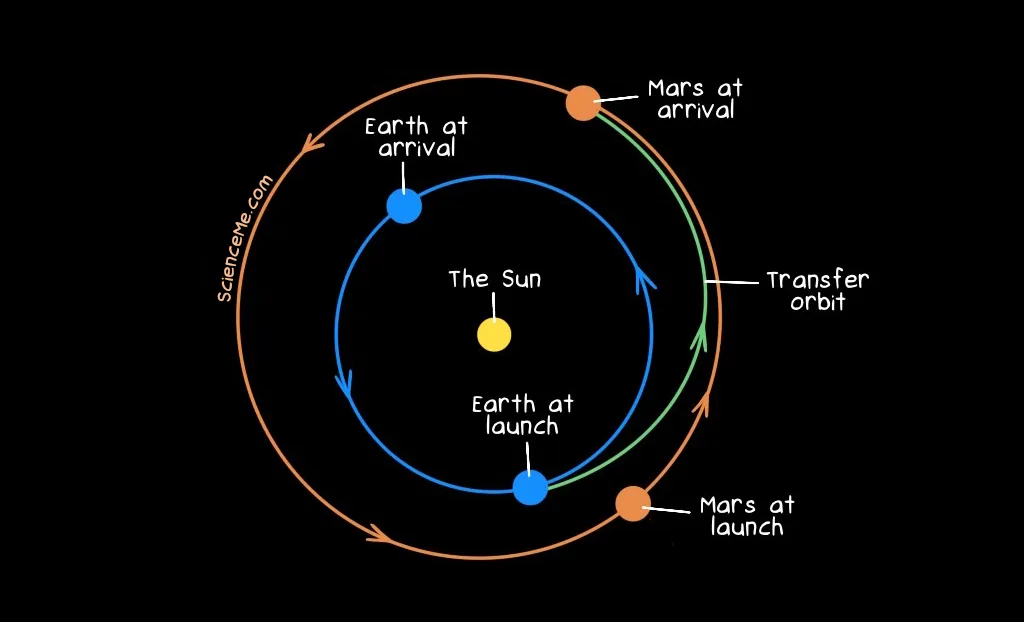
The transfer orbit between Earth and Mars requires a minimum six-month trek.
On the journey to Mars, communication with Earth will be delayed by 3-22 minutes, such that astronauts will need to resolve emergencies without technical support.
Even when the trip goes to plan, space travel puts considerable strain on the human body. In zero gravity aboard the Starship, travellers will lose bone density at a rate of 1% per month, which would compound to create serious issues on their return to Earth.
Astronauts aboard the International Space Station have to perform 2.5 hours of exercise every day to maintain their bone and muscle strength in zero gravity.
We must also consider the psychological stress and isolation of space travel. Alien taught us that in space, no-one can hear you scream. However, your fellow Starship passengers may beg to differ, politely requesting you keep your psychosis to yourself.
In short, the journey to Mars is technically viable. But it comes with a stack of risks, and not all humans are cut out for it.
Can We Live on Mars?
So the first humans arrive on Mars. What will it be like to live on the alien planet?
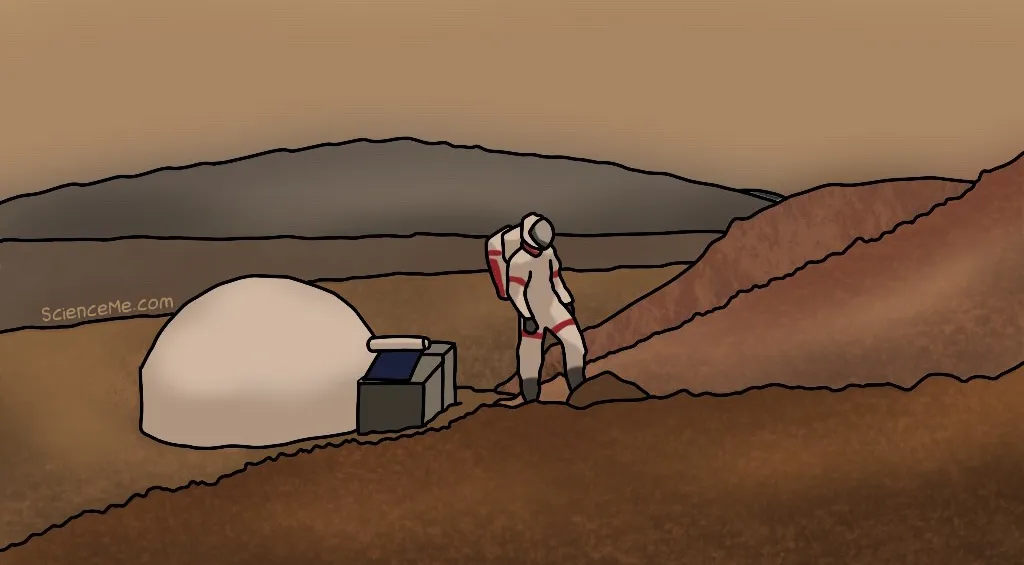
The first astronauts to colonise Mars will face extreme isolation.
Here's a fun list of day-to-day problems our astronauts can expect to encounter.
Psychological stress. Living on Mars could be very boring or very stressful; conditions which are ripe for inducing major depression. Consider the volunteers who spent a full year in a fake Martian habitat on a mountain in Hawaii. Time dragged being stuck indoors, the social dynamics got messy, and they missed the major life events of loved ones back home. The six volunteers showed remarkable resilience and held out to the end, but by no means will it be trauma-free.
Circadian disruption. Mars takes almost twice as long as Earth to orbit the Sun, with a year lasting 667 Martian days. But it's the day-night cycle that poses problems. The 24 hours and 40 minutes of each day will impact cumulatively on circadian rhythms, triggering long-term sleep disruption, mood changes, and insomnia.
Low gravity. While Mars is about half the size of Earth, it has just 10% of the mass. This makes gravity around 38% of that Earth. An 80kg adult on Earth will feel about 30kg on Mars, while their bones and muscles will degrade to match the new environment. If they plan to return to Earth, they'll have to stick to rigorous exercise routines and/or undergo physiotherapy later.
Artificial living. To maintain breathable habitats, colonists will rely on technology like MOXIE, a device that continually extracts oxygen from the carbon dioxide-rich air. Like permanent ICU patients, the first humans on Mars will be completely dependent on this kind of technology to keep them alive. Also fun to know: NASA has demonstrated that around 70% of water on the ISS can be recycled, so Mars colonists will basically be drinking each other's pee until they start drilling for water on Mars.
Dust storms. The red planet is made of iron-rich rock which produces copious red dust and the largest dust storms ever observed in our solar system. These storms can rage for months, sometimes covering the whole planet, and will render solar panels useless. Alternate energy sources will be critical to keep the life support systems running.
Volcanic threats. Let's not forget Olympus Mons, an active volcano on Mars that dwarfs our greatest mountains. Being a shield volcano with gently sloping sides, you can't see its entire profile from the ground, even from a distance. Olympus Mons is so big that it curves visibly around the planet.
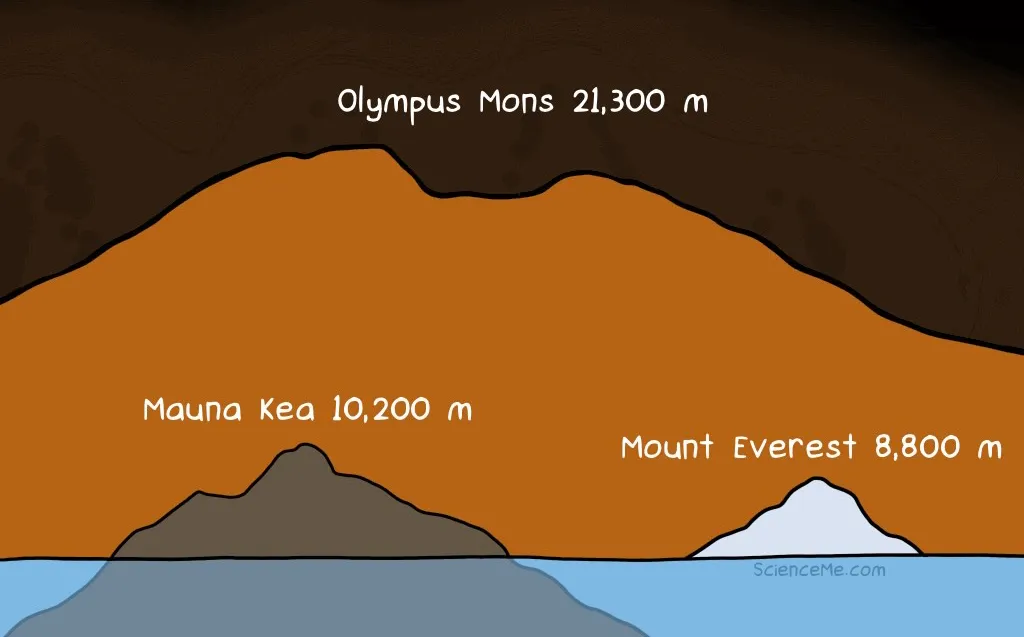
Olympus Mons dwarfs Mount Everest and Mauna Kea.
Still, if humans can survive all these hurdles, the decades that follow could see mass migration to drive construction of the first Mars city. Elon Musk predicts that as many as 100 Starships, each capable of carrying 100 people, could leave Earth at every launch window. At this rate, we could theoretically send 10,000 people to Mars every two years. Within a century, you could send a million people.
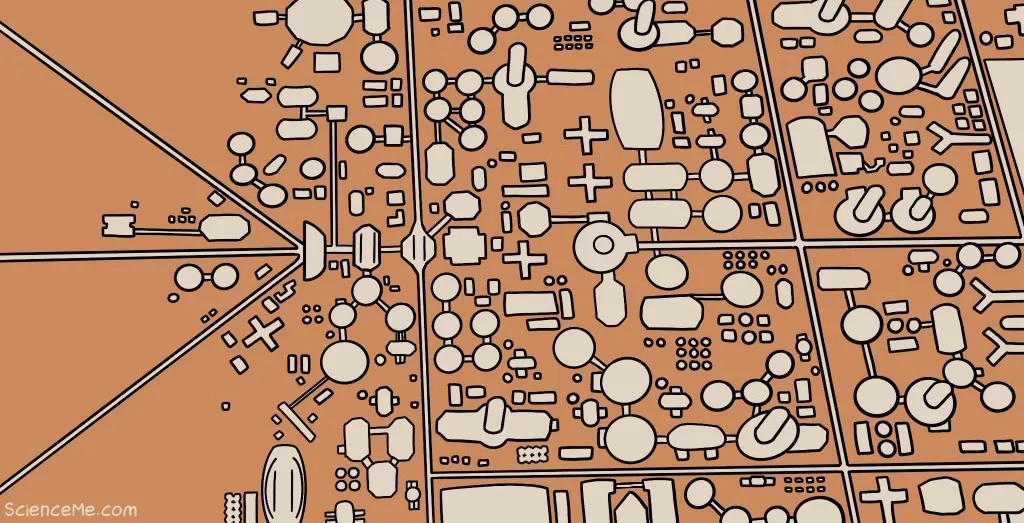
The first city on Mars will be a self-sustaining network of industrial and residential buildings.
While it's often said that Mars is similar to Earth, this is only relative to other alien worlds. In practical terms, being able to live on Mars poses enormous challenges, some of which are dramatised in the National Geographic series Mars. Besides what we considered here, it highlights a host of biological, psychological, and political hazards of colonising Mars.
Colonising The Solar System
Can we live elsewhere in our solar system? Beyond Earth and Mars, there are still six more planets and 180 moons we might evaluate as alternative human habitats.
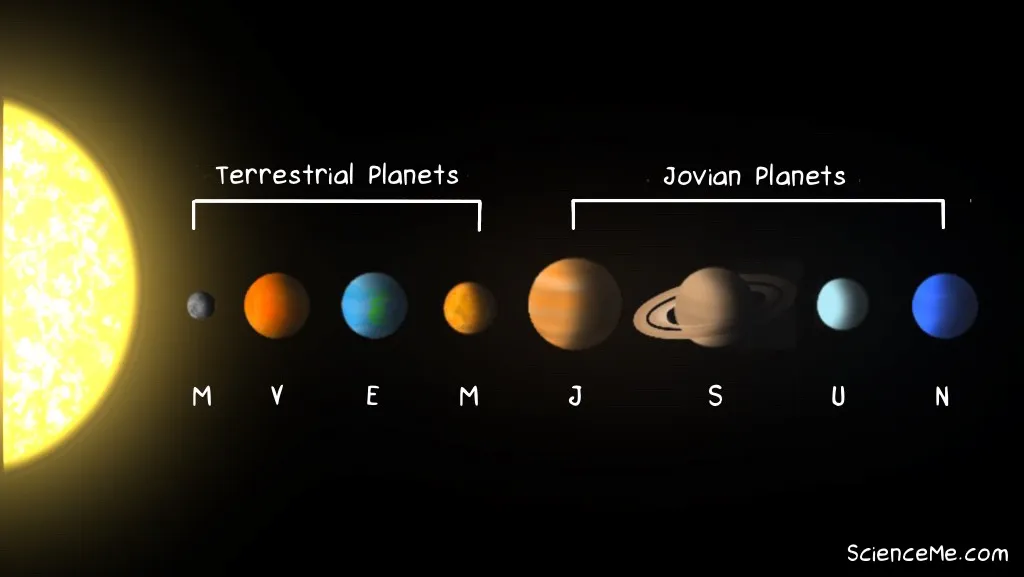
The Terrestrial and the Jovian Planets of our solar system.
Mercury is a Hot Mess. Mercury orbits closest to the Sun at just 58 million km, which makes the surface heat and radiation extremely intense. Temperatures reach 426°C (800°F) by day and -173°C (-280°F) by night. Even a lead-based sunblock would melt off your face.
Venus is Another Hell Ball. Venus orbits further out from the Sun at 108 million km but is still far too hot for us to handle. Day or night, north or south, surface temperatures are an even fiercer 460°C (860°F) due to the thick carbon dioxide atmosphere.
Jupiter Would Crush Us. Jupiter is the largest planet in our solar system with a mass 2.5 times greater than all the other planets combined. Its atmosphere is so thick it literally crushes our probes with its pressure. We do know, however, that beneath the dense atmosphere, Jupiter becomes liquid and then solid, with pressures 50-100 million times stronger than at our sea level.
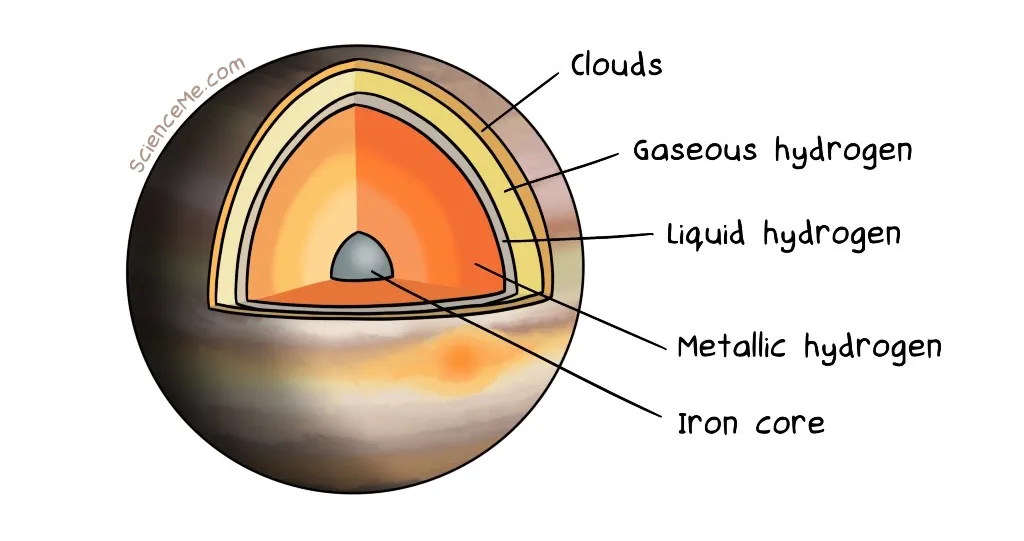
The gas, liquid, and solid layers inside Jupiter.
Jupiter has a funny way of spinning, moving faster at the equator than at the poles. It also has the fastest rotational speed in the solar system, producing 10-hour days and winds of 480km/h (300mph).
Jupiter's Great Red Spot is a never-ending storm, first sighted in the 17th century. The storm is more than twice the size of Earth and marks an area of super high pressure.
All in all, Jupiter looks pretty inhospitable. But it also has 69 moons, the most famous of which are Europa and Callisto.
Europa is a Smooth Ice Moon. Photos of Europa show a smooth icy surface, devoid of craters due to ocean currents continually recycling the ice. The moon is -160°C (-256°F) at the equator and -220°C (-364°F) at the poles. It's prone to ice quakes and violent water plumes exploding through the surface.
The same side of Europa always faces Jupiter, and with no atmosphere, it's continually bombarded with deadly radiation. And yet the ocean beneath the ice could harbour aliens. NASA is mulling over number of exploration vehicles including the amphibious squid rover to find out if there's already life on Europa.
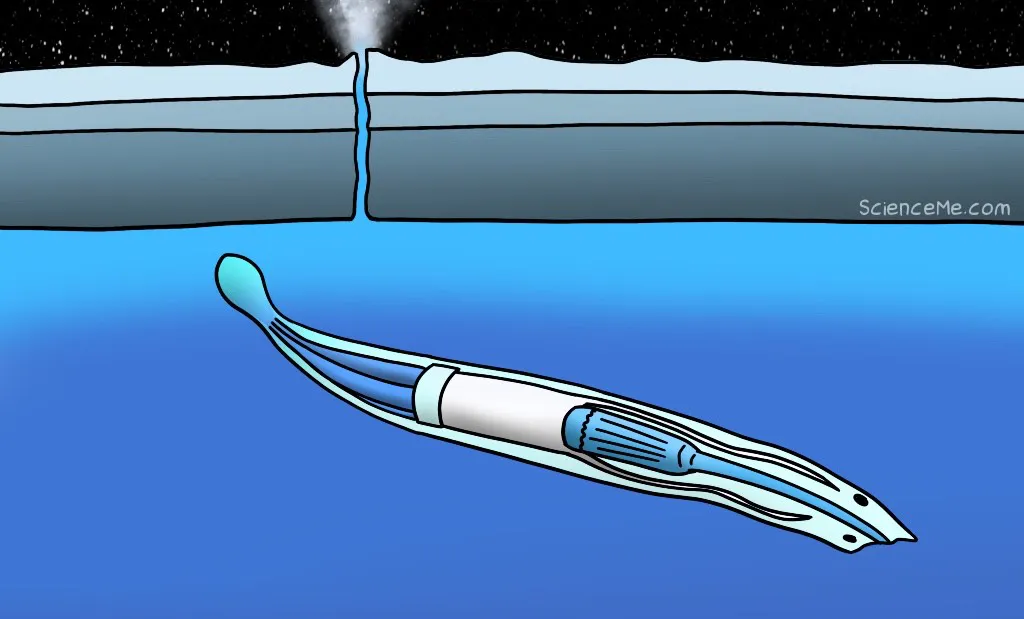
The amphibious squid rover could explore Europa's chilly oceans.
Callisto is a Cratered Ice Moon. Callisto is famous for being the most heavily cratered object in our solar system. The lack of weather and geological activity means that ancient craters never disappear, and yet, the ocean beneath the ice could also support cold-tolerant life forms. This is a major enticement to set up base camp on the surface.
The Search for Earth-Like Exoplanets
As we look around our solar system, Mars once again looks pretty decent. But this is just our local neighbourhood. Space telescopes like the Kepler Space Observatory and the James Webb Space Telescope allow researchers to detect the presence of rocky exoplanets and analyse their atmospheres.
Most exoplanets can only be observed indirectly because they're so far away. When an exoplanet passes in front (or even behind) its host star, the transit creates a change in solar luminescence. This provides the telltale sign of an exoplanet in orbit.
Analysis of the different wavelengths of light provides information on the atmospheric composition of the exoplanet, including water, temperature, and clouds.
More than 4,000 exoplanets have been confirmed so far, prompting the estimate of 300 million Earth-size planets in the habitable zone of sun-like stars across the Milky Way.
The closest exoplanet to Earth is Proxima Centauri b, some four light-years away. While it has a viable mass of about 1.3 times that of Earth, it orbits terribly close to its parent star, exposing it to extreme ultraviolet radiation.
Our prime candidate for an Earth-like planet is Kepler-186f, some 490 light years away.
If that sounds close—it isn't. If we consider that our fastest space probe would take 20,000 years to travel one light-year, then our best planetary candidate has a journey time of almost 10 million years. In making the journey, the species to arrive on Kepler-186f would heartbreakingly different from the ancestral species that departed Earth.
Perhaps future technology will solve this problem. The laws of physics say we'll never travel at the speed of light, but what of teleportation? Though there are technical challenges to overcome, the theoretical physicist, Michio Kaku, says that human teleportation may be possible within 100 years. He imagines a machine like an ultra-high resolution MRI scanner that transmits us as data, atom by atom, which raises an interesting dilemma as to the nature of the self.
Final Thoughts
As we contemplate our future as a multiplanetary species, some fear that it equates to giving up on Earth. After all, we've mined our home planet for natural resources, crashed its biodiversity, and primed it for climate ruin. Does colonising Mars make Earth a disposable planet?
Despite the tragedy of these facts, expanding to Mars will not render Earth obsolete to humanity. Earth would far sooner ditch us. Indeed, in 50,000 years, it will unleash the next glacial period, creating catastrophic cooling and extinctions. This will last for 90,000 years. Humanity itself may not survive.
We are a mere blip on the geological timeline, fighting for survival like every other lifeform that has walked, crawled, and slimed its way around the planet. As a species capable of self-preservation, we may be morally obligated to hedge our bets by establishing discrete colonies on moons and other planets. This will distribute the eggs of humanity across many baskets, so that one catastrophic basket loss won't commit our species to extinction.
"You want to wake up in the morning and think the future is going to be great—and that's what being a spacefaring civilization is all about." - Elon Musk

Could The Last of Us Happen?
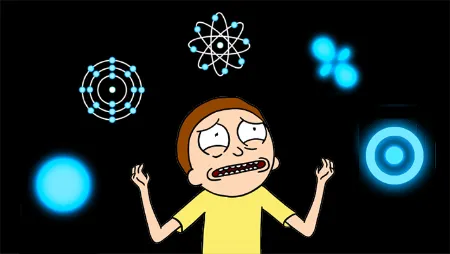
What is An Atom?

How Does Gene Therapy Work?
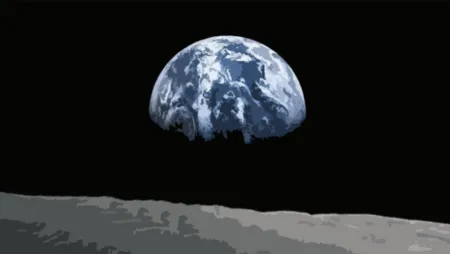
Helium Could Save Our Planet
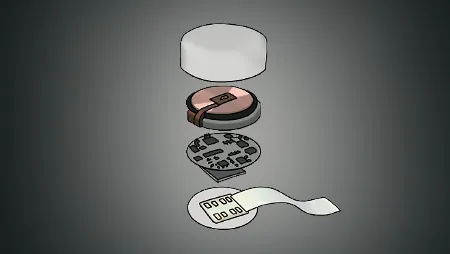
Neuralink and You

How Was Stonehenge Built?

A Man Walks into a Teleporter
